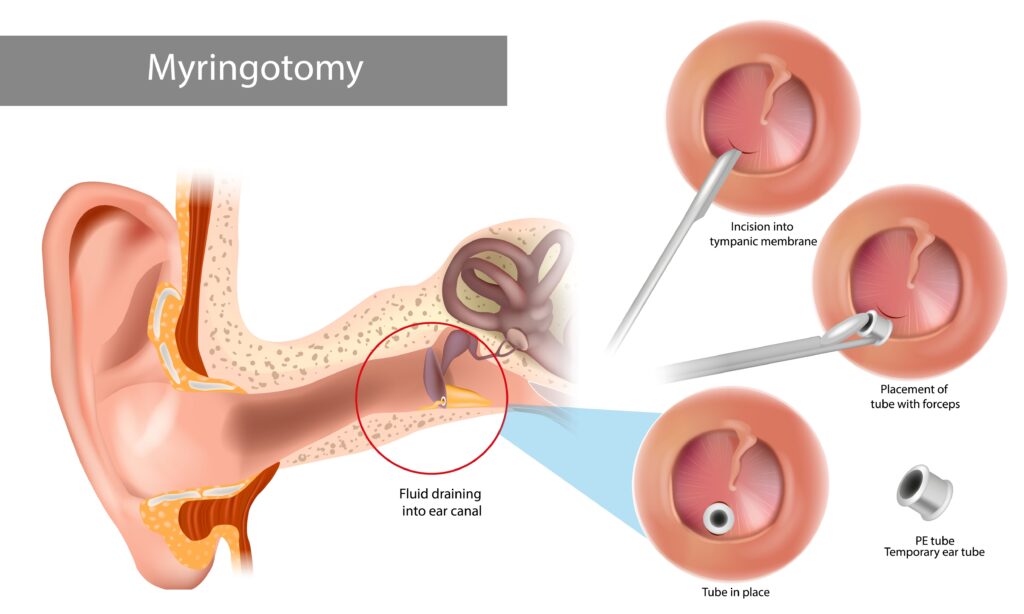
menu

Posted in Uncategorized | October 25, 2023

Does your child get ear infections often? If multiple courses of antibiotics haven’t successfully cleared the ear infections or it’s affected your child’s ability to hear, you may want to consider ear tubes. Ear tubes can resolve persistent infections and ease your child’s discomfort.
Keep reading to learn more about ear tubes, how they work, and 5 signs your child could benefit from ear tubes.

Ear tubes are also called tympanostomy, pressure equalization, ventilation, or myringotomy tubes. They are super small and about the size of a matchhead.
Ear tubes can be made from plastic or metal and look like tiny, hollow cylinders. An ENT specialist surgically places them into the eardrum or tympanic membrane.
Although they may look small, ear tubes perform a critical job. Putting in ear tubes helps open the middle ear, allowing airflow between the middle and outer ear and fluid drainage.
Ear tubes are highly successful in considerably reducing ear infections. Most children will have an ear infection or two a year, and any infection normally drains on its own through the tiny opening created by the ear tubes.
Once an anesthesiologist puts your child to sleep, the ENT specialist will remove any wax and debris in the ear canal. Next, your child’s ENT specialist will create a tiny incision in the eardrum and remove fluid from the middle ear with suction.
Finally, they will insert the ear tube into the incision. Ear tube surgery or myringotomy is an outpatient procedure that takes approximately 10 to 15 minutes to complete.
Because it’s difficult for children to hold still, the procedure is done in an operating room with general anesthesia. General anesthesia is safe, and your child is closely monitored the whole time.
After having ear tubes inserted, your child’s symptoms and mood should significantly improve.
For most patients, ear tube removal isn’t necessary. The inserted tubes often fall out on their own after about 6 to 18 months, pushed out as your child’s eardrum heals.
Ear wax then moves it to the outer ear. If an ear tube drops away too soon, an ENT specialist at Specialty Care Institute may need to replace it.
Less commonly, your child may require another procedure to remove the ear tubes if they don’t fall out. The most common ages for ear tube surgery are ages 1 to 3.
However, infants as young as six months can still get ear tubes. By age 5, most children have longer and wider Eustachian tubes that allow for proper drainage of fluid.
While ear tubes won’t prevent your child from developing another ear infection, they can reduce their severity and frequency.
Your child may benefit from ear tubes if they have:

ENT specialists typically use a wait-and-see approach or prescribe low-dose antibiotics after a child has had a few ear infections. However, these methods are only sometimes effective.
If your child’s ear infections return soon after they stop using medication or don’t clear up at all, your ENT specialist may recommend ear tubes. Ear tubes can help avoid possible antibiotic resistance and prevent new ear infections to help keep your child more comfortable.
If your child has four ear infections within a year or three ear infections within six months, it’s considered chronic. In that case, the ENT specialist may recommend surgery.
Ear tubes can prevent or reduce the number of ear infections your child gets in the future and the risks linked to them.
Otitis media with effusion or middle ear fluid is the presence of fluid in the middle ear. Your child may have fluid in their middle ear even if they don’t have an ear infection.
The fluid can result from Eustachian tube dysfunction, a cold, or nasal congestion.
Excess fluid can be damaging. For instance, it may cause a ruptured eardrum. If the fluid sits for over three months and doesn’t go away, the ENT specialist may recommend ear tubes to remove that fluid.
A chronic ear infection, fluid buildup in the middle ear, and recurring ear infections can eventually lead to eardrum collapse. A collapsed eardrum may result in additional complications, such as bone erosion in the middle ear and decreased hearing.
If your child has a collapsed eardrum, ear tubes can help prevent further complications.
A recurring or chronic ear infection that lingers for months and causes fluid buildup can affect your child’s hearing. The fluid makes your child hear sounds and words as though they were underwater, which distorts the sounds they hear.
Distorted sounds are hard to understand and may lead to speech delays. If your child has hearing loss or speech delay, they may benefit from ear tubes.

Ear tube surgery at Specialty Care Institute can benefit your child if they suffer from persistent ear infections or fluid buildup. The expert team of ENT specialists at Specialty Care Institute will thoroughly assess your child to determine if they need ear tubes.
Are you concerned about your child’s repeated ear infections? Schedule your appointment today at Specialty Care Institute at one of our locations in Arlington Heights, Barrington, Elgin, or Hoffman Estates, IL, to find out if ear tubes can help your child.